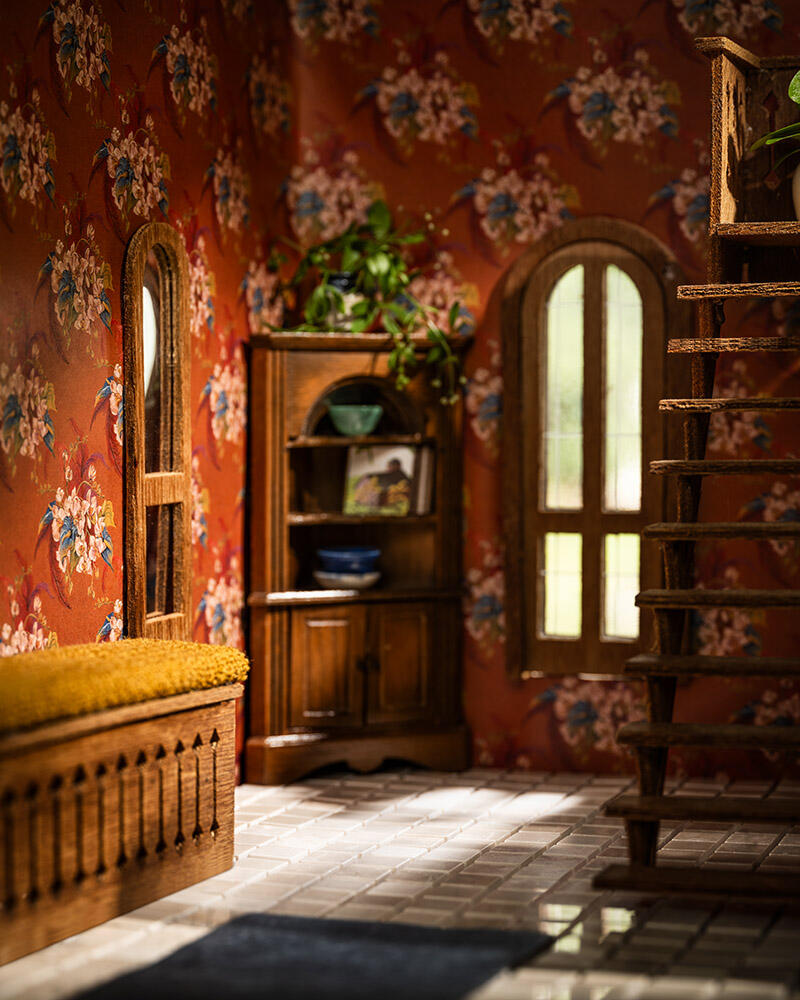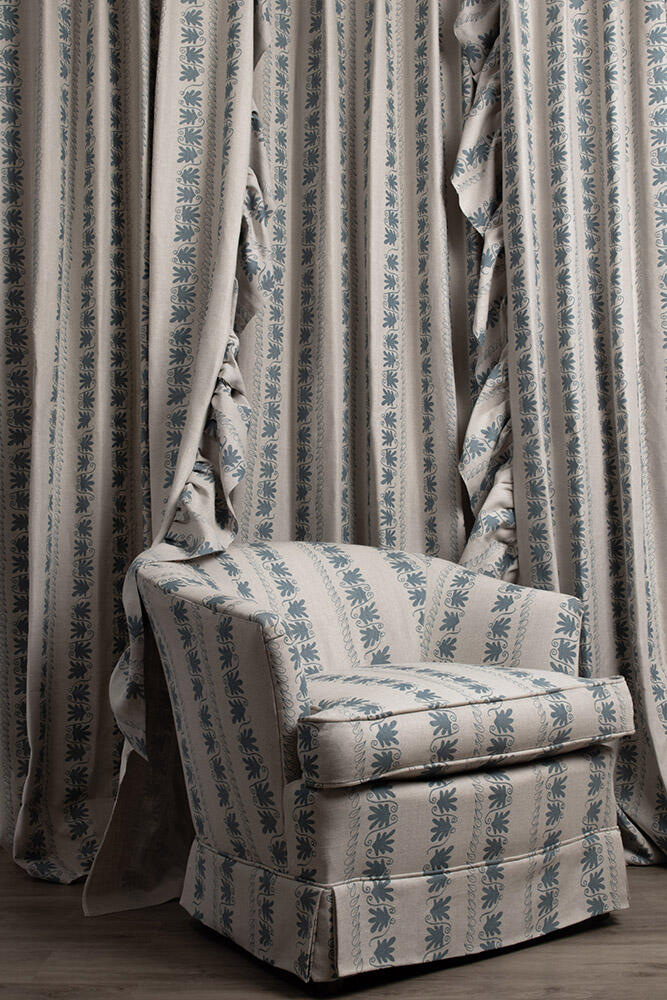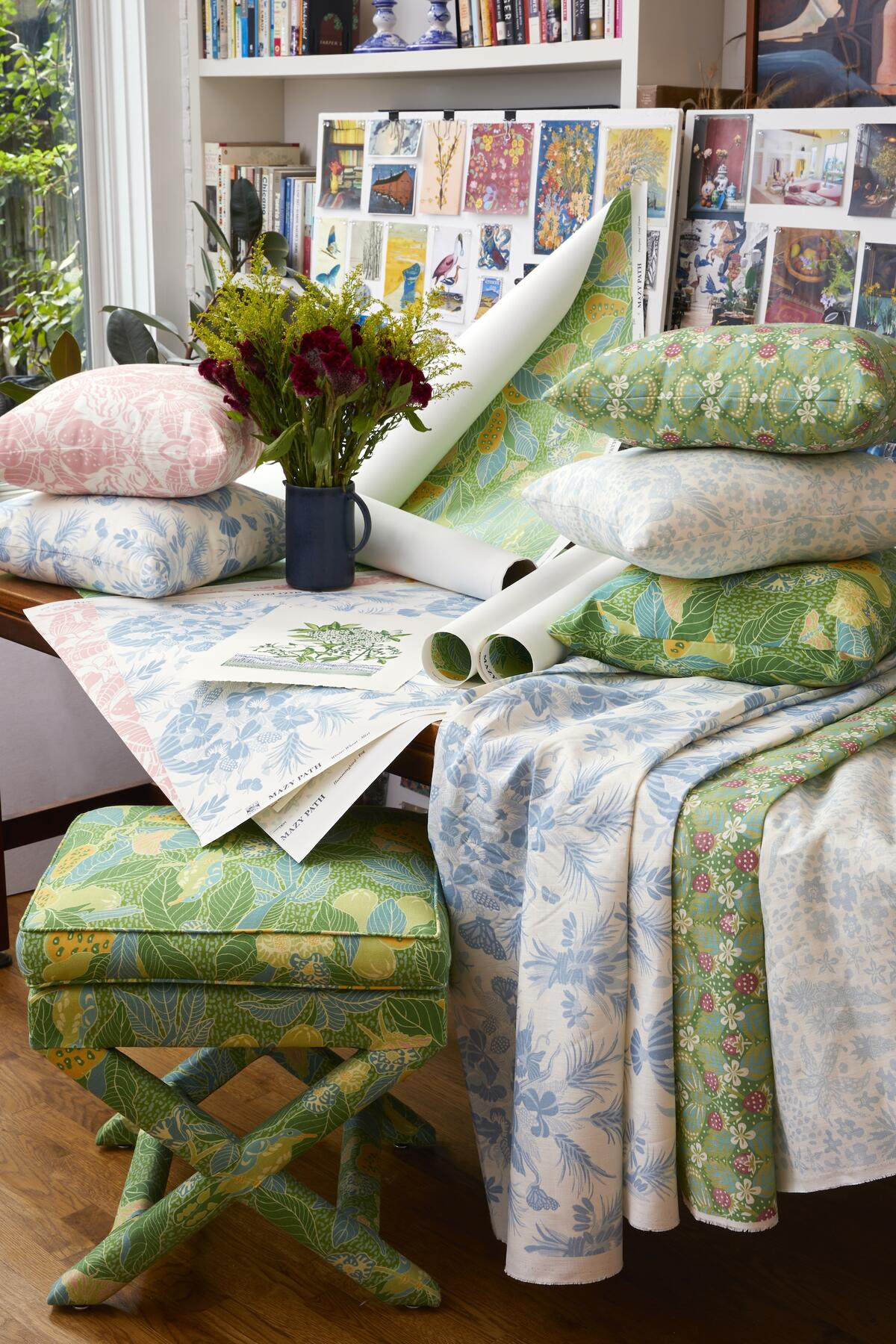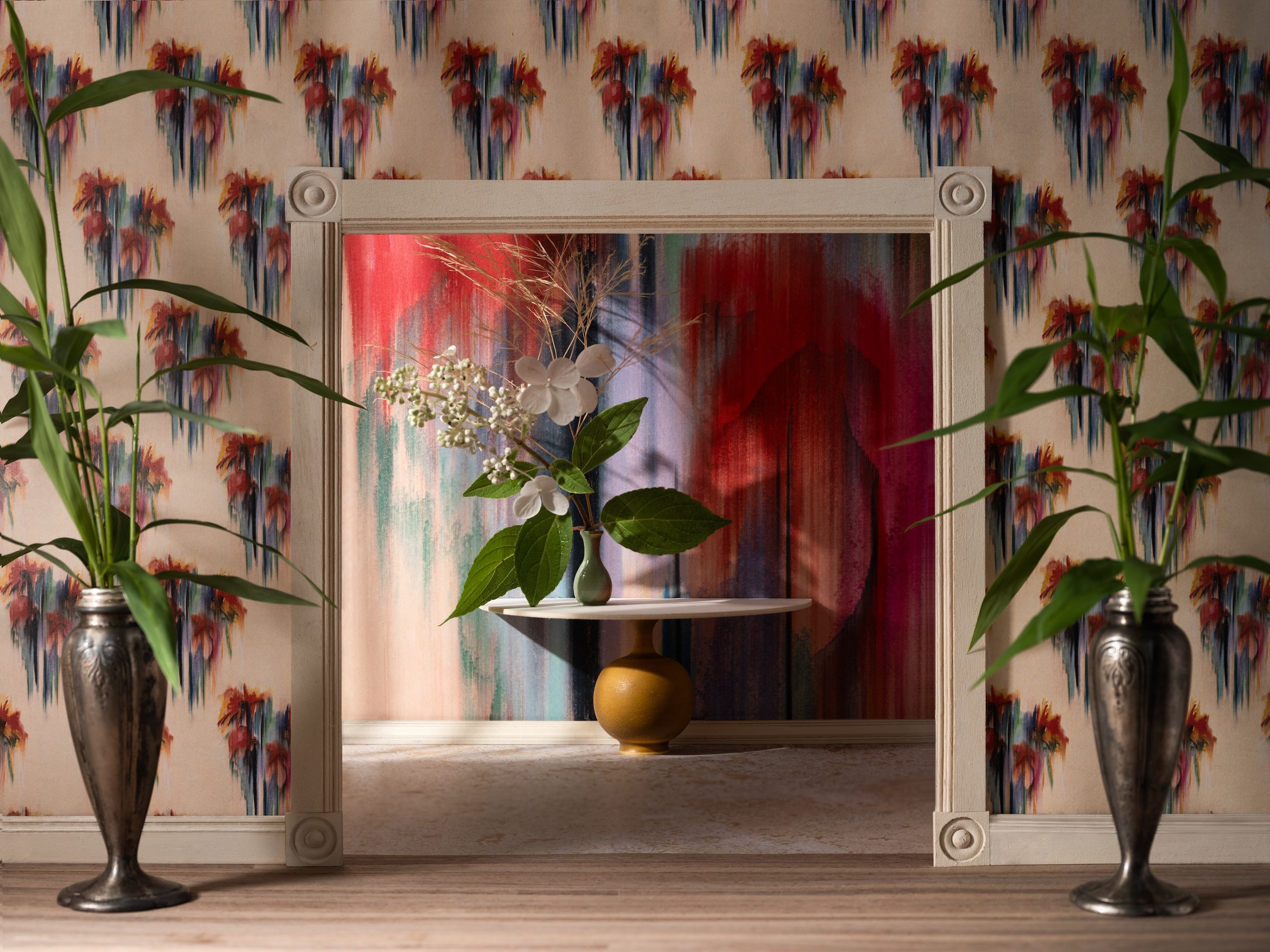Creating beautiful products is one thing; getting designers to take a chance on a new fabric or wallpaper brand is another. In order to successfully market to the trade, textile designers must figure out how to help interior designers visualize and understand their product without spending so much money that the whole endeavor becomes unprofitable. Among boutique brands, many of which operate on a made-to-order basis, those challenges can be magnified, as their margins are considerably slimmer. “It’s about doing the most with the least—and doing it creatively so it doesn’t look like the least,” says Paola Meléndez, the designer behind Puerto Rico–based fabric brand Paola Melendez Casa.
When it comes to wallpaper lines, many independent brands have found that the most budget-friendly way to show scale is to Photoshop the individual SKUs onto digital images. So a wallpaper brand might buy an inoffensive Adobe Stock image, or have a photographer take a simple picture of a white wall with some versatile furniture positioned in the corner, and then superimpose different wallpaper designs onto that image. Danica Andler, the creator of custom wallpaper line AND, would alternate between the Photoshop technique and tacking up her wallpapers in the homes of friends and family in order to show them in situ. “I had fun doing that, but it was always a corner or one wall—I wasn’t able to display my work on a large scale,” says the Los Angeles designer. “And the Photoshopping was just so unsatisfying. Like, I’m making something interesting and tangible, and then I’m dropping it into this uninspired environment. I’m really thankful that the technology exists to do that, but I was starting to feel like I needed to put my handcrafted wallpaper in a handcrafted environment.”

She decided to take a chance on an idea of miniature proportions: designing a dollhouse to display her work in the way she’d been dreaming of. “It seemed like such a better way to communicate my vision to my clients,” says Andler. “I could build a space that had a strong point of view and could be a bit sensational—something that would spark a conversation.” The resulting images feature miniature rooms decorated with scaled-down versions of the designer’s wallpapers. The photos are both grand and slightly surreal, offering a clear view of her brand identity. She plans to keep making them to display future collections.
Andler’s journey is one that many boutique wallpaper and textile designers have undertaken, albeit with various outcomes. Kathryn Faull, the founder of Chicago-based Maresca Textiles, says that while she understands the utility of a stock image with a wallpaper digitally inserted, she tries to avoid it when she can. “I get that it’s a clear way for a client to get a concept of the scale and color, but it’s usually obvious that it’s digitally done, and I think you lose a lot of authenticity,” she explains.
However, avoiding the digital route isn’t always possible because of the financial and logistical demands of doing a full-blown textile photo shoot. For a small brand like Andler’s, any wallpaper used on a shoot becomes a sunk cost. (Even some of the biggest players in fabric and wallcoverings rely on 3D renderings and augmented reality tools to digitally display their SKUs. “It would be impossible to photograph every one of our products,” says David Klaristenfeld, the vice president of Fabricut, which also owns S. Harris, Vervain, Stroheim, Clarence House and Trend. “We come out with thousands of new SKUs every year. We try very hard to photograph as much as we can, but it’s just not possible.” For wallpaper imagery in particular, Klaristenfeld says 3D renderings have broadened the amount of products the brand is able to show in situ, and that Fabricut has an in-house team dedicated to doing just that.
After founding her brand in 2010, Faull got by for years doing flat lays and simple photo shoots where her textiles and wallcoverings were tacked up on a wall with some furniture and decor styled in front. During the pandemic, she was searching for a photographer and stylist she could work with remotely, and she found Andrew Stewart, who had also done brand photography for fabric brand Zak+Fox. “He’s been a creative director, and he has such passion. He’s able to come up with really interesting setups that go beyond basic vignettes,” she says.


In one of Faull’s favorite shoots, Stewart built a chic doghouse and pasted Maresca’s prints on it. The set piece was the focal point, sitting in front of a layered backdrop of the brand’s patterns. In one setup, a live speckled hen roosts on top of the structure. “It was collaborative and wonderful, and it gave us a chance to play with the mix of patterns,” says the designer. “It was a huge turning point for me, to work with someone who had a more creative vision for my work. As a fabric designer, I’m used to thinking in one way, so to partner with someone who thinks three-dimensionally and can see ways to sculpt the textiles in new ways sets our brand photography apart.”
Vera Neykov, the founder of New York–based Milton Textiles, made the decision to do just one collection a year, in part so that she could pool her resources and do a full-scale editorial shoot to promote it instead of trying to make do with scrappier brand imagery for multiple drops. “It gives me the opportunity to have my idea come through on a bigger scale,” she says. That mindset differs from that of larger textile companies, which often stay in front of their client by releasing new lines on a monthly basis.
Mazy Path founder Alexis Audette—whose textile and wallcovering line is based on her botanical linocuts—was urged by a designer client last year to change things up. “A designer asked if I sold the linocuts that my wallpaper originated from,” says the New York–based designer. “My number-one marketing strategy had always just been to get in front of as many people as I could, and I was always amazed at how many people would ask me who designs the line. So when this designer suggested that I start selling the original art prints, it seemed like such a great way to differentiate myself and to drive home that this line is based on actual artwork.”
Audette came up with another creative way to gain exposure when she started offering linocut workshops in design studios. “It can be hard to get an appointment with a firm just to show my 19 SKUs, but offering to do the workshops as well has allowed me to bring something else to the table,” she says. “And I get the chance to really tell my story and connect with my target audience in a way that fosters community. There’s something really special about just sitting quietly in a room, making art together.”

For many small businesses, regularly mailing out bundles of samples is as effective a marketing strategy as any. “Some brands are reluctant to send samples because it’s expensive, but from my perspective, I want to get as many samples out as possible, because I feel like clients need them in their hands,” says Faull. “That’s the only way they’re going to remember my brand.”
Meléndez has found success by incorporating personal touches into her marketing strategy. She likes to include screen-printed notecards with a message and even a favorite quote when she mails out bundles of fabric samples. “I’ve spent a lot on brand photography and making a catalog, but then when I log on to Instagram, the thing I get tagged in the most is the cards that I made for people,” she says. “Designers were posting pictures where they had my note propped up on their desk. It cost me 10 cents! It was a great reminder that the most expensive thing isn’t always going to be what resonates with people. It’s about emotion and what you can do that touches people’s hearts and speaks to them.”
It’s that outlook that has allowed Meléndez and other boutique brand owners to operate successfully. “I think there’s an idea that you have to have a certain amount of money in order to compete in this industry, that you can’t start your own brand unless you have the budget to hire a publicist and do an elaborate photo shoot,” she says. “You can do it. You can compete—you just have to be creative about it.”



























